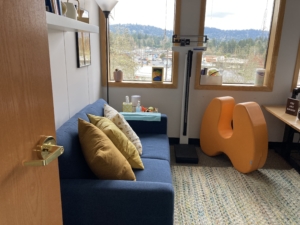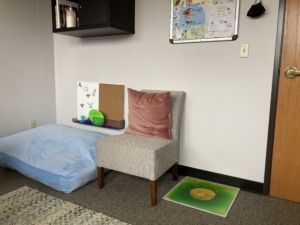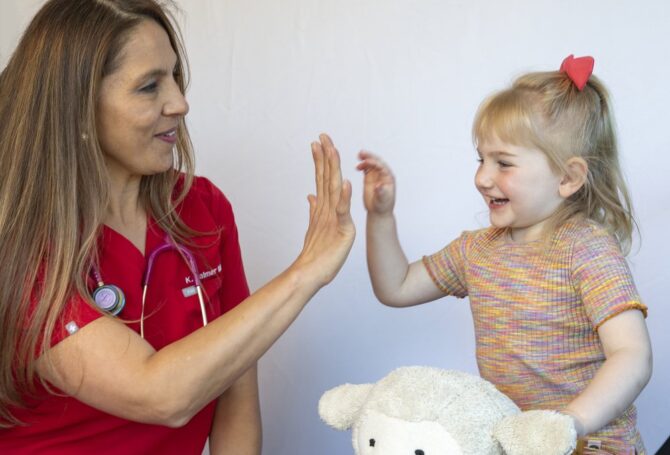
May 23, 2022

“The reason I went into pediatrics is to do the work that I’m doing now,” says Joy Eberhardt De Master, MD, FAAP.
Dr. Eberhardt is a behavioral-developmental pediatrician in Portland, and is in the fifth month of running her new practice, Orchid Pediatrics.
Dr. Eberhardt completed her pediatric residency in 2009 and was board certified the same year. She worked in primary care for four years before realizing her heart was in specialty care. In 2013, she began conducting child maltreatment assessments with Kaiser Permanente. In 2018, Dr. Eberhardt started transitioning to developmental & behavioral pediatrics.
For National Mental Health Awareness Month, Dr. Eberhardt shares how she designed her clinic space for kids with a wide range of developmental and behavioral differences, and how other pediatric clinics can make their spaces more sensory-friendly.
DR. EBERHARDT’S CLINIC SPACE

Dr. Eberhardt says that an engaging and creative office setup is fun for kids and allows her to get a fuller view of her patients as she completes assessments.
When you step into her office, there is a green and yellow sensory tile on the floor, inviting patients to squish around on the soft gel pad.
“Some kids like to stomp on it, some like to step on it, and some kids like to avoid it. And I feel like some kids don’t even notice it! I’m always curious to see how they’re going to engage with it as they enter the room,” she says. “It can be very helpful to observe as I’m getting to know their personalities and how they approach the world.”

Dr. Eberhardt’s office also features a large, orange, tooth-shaped cushioned structure that encourages kids to move, to take space from the environment, or whatever they may need.
“I have a patient who always comes in and sits right in the middle of it. She loves wobbling around the whole time she’s chatting with me.”
She says the structure also works well for kids who want a little more trunk compression, as it can give them a gentle hug if they lay flat in it or sit in it.
“I’ve had one kid who has used it as a sensory avoiding thing. He hid his head in it to get away from stimuli.”

SIGHTS, SOUNDS, AND MOVEMENT
To help child health providers evaluate their spaces, Dr. Eberhardt suggests considering “Sights, Sounds, and Movement.”
Sights
Sights might include colors, artwork, or textures, but also lighting. In her own space, Dr. Eberhardt opts for upward facing lighting rather than overhead.
Sounds
Dr. Eberhardt suggests taking inventory of the office equipment, thinking about what kinds of sounds the equipment makes, and asking how those noises might play into the patient visit. She said that if there are potentially jarring noises, you can prepare patients by letting them know ahead of time.
“I used to work in an office with exam tables that moved up and down, and one of the exam tables was particularly noisy. So before I used it I’d tell patients, ‘OK, this is going to be noisy now. It’s going to sound like a motor.’ And I’d move it a little bit and see how they’d react. Usually, if I gave them a warning, kids did well with it.”

Movement
Dr. Eberhardt recommends considering how to invite patients to move around in spaces like waiting rooms.
“Do you have spaces that encourage movement and gross motor play, like big body movements? And then do you have places where people can have a sense of enclosure and quiet?”
ON THE ROOMING PROCESS & TRANSITION OBJECTS
Dr. Eberhardt says that for some kids, it can be helpful to offer an object to bring from the waiting room to the exam room. She calls these “transition objects,” and suggests items like soothing bubble chambers or weighted stuffed animals and lap pads.
“You can get some [weighted stuffed animals] that are completely wipeable,” she says. “Kids can find these helpful because of the sensory input of touching them, but also because of the weighted compression on their bodies as they take the animals from room to room.”

RESOURCE SUGGESTIONS
- Fun and Function – Large selection of toys and therapy products for children with special needs like ADHD, autism, or sensory processing disorders
- Spectrum Life Magazine – Stories, resources, and inspiration — written by and for the autism community
- ADDitude Magazine –a magazine, community & website dedicated to strategies and support for individuals and families living with ADD and related conditions
Neither OPS nor Dr. Eberhardt are being compensated for sharing the products linked above. These are simply ideas and examples.



